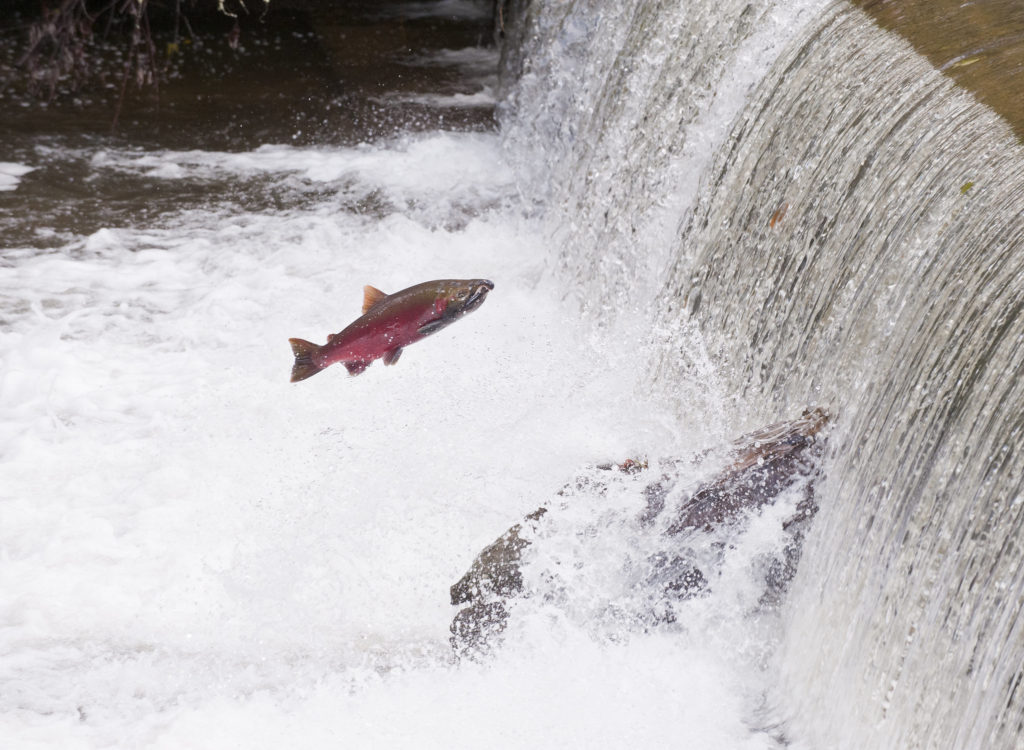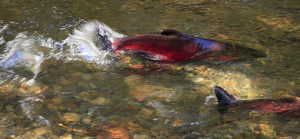
By MICHELLE KLAMPE/OSU News Service
NEWPORT – A new study of the genetic profiles of wild and hatchery coho salmon demonstrates important distinctions in how the two types of fish form mating pairs.
These findings by Oregon State University researchers provide new insight into subtle differences between wild and hatchery fish that could lead to changes in how hatchery fish are mated to promote the success of hatchery fish and conserve and protect wild fish.
“If we can learn more about how natural origin fish mate in the wild, and if that differs from how hatchery fish mate in the wild, we can potentially gather new information to improve mating strategies applied in hatcheries,” said Heather Auld, a post-doctoral research associate at Oregon State University’s Coastal Oregon Marine Experiment Station and the study’s lead author.
Wild coho salmon are listed as threatened under the U.S. Endangered Species Act throughout much of their range, including along the Oregon coast and lower Columbia River, due to overfishing, pollution, other losses associated with their freshwater habitat and poor ocean conditions related to climate change.
Efforts 40 years ago to bolster their numbers focused heavily on producing hatchery fish. But wild salmon proved better at reproduction than those from hatcheries.
Researchers also found that hatchery-spawned fish may have a negative impact on wild fish and their ability to reproduce.

“It has been demonstrated across four salmon species that hatchery fish that breed in the wild are not as viable as wild fish,” said co-author Michael Banks, an OSU fisheries professor in the Coastal Oregon Marine Experiment Station at Hatfield Marine Science Center. “And should they breed with wild fish, there is risk of drawdown of the number of offspring that result from wild fish.
“What we’re trying to find now is a way to make a better hatchery fish that doesn’t have drawdown impacts on the wild fish,” Banks said.
The research was supported by an award from the Oregon Hatchery Research Center Fund administered by the Oregon Department of Fish and Wildlife. The OHRC is located 25 miles east of Waldport on Fall Creek, a tributary of the Alsea River.
Researchers use genetic codes
Using genetic material collected from fin clips, the researchers conducted genotype sequencing, where an individual fish’s entire genome is scanned for specific markings and analyzed to reveal the genetic profiles of hundreds of wild and hatchery fish.
They found that both hatchery and wild fish tend to look for mates that are different from themselves genetically. Mating for difference is a way to improve resistance to disease, Banks said.

But the researchers found that hatchery fish and wild fish demonstrate that make selection at different genetic markers. And while the researchers have identified these differences, they still don’t know much about many of these genes associated with mate selection.
Using information from this study and previous work, the researchers are now trying to better emulate the natural mating of coho salmon in a hatchery environment. Working out of the Sandy Hatchery on Cedar Creek, a tributary of the Sandy River east of Portland, the researchers are collecting tissue samples from fish that have returned to spawn and then attempting to find genetic matches similar to those found among wild fish.
For each female, they split the eggs into two batches. Half of the eggs are fertilized with a randomly selected male, as is typical for hatchery practice. The other half are fertilized with a “best” male selected based on genetic profile information as observed from wild fish mating in a natural context.
“We are doing a directed spawn where we are trying to emulate nature,” Banks said. “This is not a simple feat because we observed from nature that most genes are associated with choosing a mate that is different, but also some genes are associated with choosing something similar.”
The researchers worked with Dana Gibbon, a bioinformatics analyst from the Center for Quantitative Life Sciences, to develop a new computer algorithm, called MultiFaceted Choice, to provide best choices among males and females arriving on the spawning table.
The researchers will return soon to the hatchery to mate fish again for the third year of the three-year experiment. This is also the first year they expect to encounter the first returning jacks, or young male salmon, from the first year of their experiment.
“Some of the jacks will be starting to come back this year, and we expect all returns from next fall through 2025 will be from our experiment,” Auld said. “We will continue to keep taking genetic samples throughout that period to determine if this process was successful.
“Depending on what we find, this could potentially alter how we mate hatchery fish. And it may result in hatchery fish that are more like wild fish and have less impact on wild fish.”


